Semi-Analytical Solutions for One-Dimensional Consolidation of Viscoelastic Unsaturated Soils Considering Variable Permeability Coefficient
Abstract
1. Introduction
2. Governing Equations
2.1. Mathematical Modeling
2.2. Laplace Transform and Governing Equations
3. Derivations of the Solutions
3.1. Semi-Analytical Solutions
3.2. Considering Variable Permeability Coefficient
4. Verifications and Examples
4.1. Verification
4.2. Influence of on Consolidation
4.3. Influence of on Consolidation
4.4. Influence of on Consolidation
4.5. Analysis of the Permeability Coefficient Variation
4.6. Influence of the Permeability Coefficient Variation on the Consolidation
5. Conclusions
- (1)
- The parameter has no impact on the dissipation of EPAP and EPWP during the early stage. As increases, the coefficient of consolidation becomes larger, and the dissipation of EPWP occurs earlier and more rapidly in the later stages.
- (2)
- The influence of the viscosity coefficient on EPAP and EPWP is very small. However, a larger viscosity coefficient slows the rate of soil deformation, leading to slower consolidation.
- (3)
- The permeability coefficients of the air and water phases both change during the consolidation process. The permeability coefficient of the air phase returns to the initial value after the completion of consolidation, while the permeability coefficient of the water phase is lower than the initial value.
- (4)
- Considering the variations of the permeability coefficient of the water phase and air phase, the dissipations of EPAP and EPWP will accelerate. Via comprehensive analysis, it can be found that is the greater influencing factor in the early stage of the consolidation and is more important in the later stage.
Author Contributions
Funding
Institutional Review Board Statement
Informed Consent Statement
Data Availability Statement
Conflicts of Interest
References
- Biot, M.A. General theory of three-dimensional consolidation. J. Appl. Phys. 1941, 12, 155–164. [Google Scholar] [CrossRef]
- Bishop, A.W. The principle of effective stress. Tek. Ukebl. 1959, 39, 859–863. [Google Scholar] [CrossRef]
- Blight, G.E. Strength and Consolidation Characteristics of Compacted Soils. Ph.D. Thesis, University of London, London, UK, 1961. [Google Scholar]
- Scott, R.F. Principles of Soil Mechanics; Addison Wesley Publishing Company: Reading, MA, USA, 1963. [Google Scholar]
- Barden, L. Consolidation of compacted and unsaturated clays. Geotechnique 1965, 15, 267–286. [Google Scholar] [CrossRef]
- Fredlund, D.G.; Hasan, J.U. One-dimensional consolidation theory unsaturated soils. Can. Geotech. J. 1979, 16, 521–531. [Google Scholar] [CrossRef]
- Fredlund, D.G.; Morgenstern, N.R. Constitutive relations for volume change in unsaturated soils. Can. Geotech. J. 1976, 13, 386–396. [Google Scholar] [CrossRef]
- Ausilio, E.; Conte, E. Settlement rate of foundations on unsaturated soils. Can. Geotech. J. 1999, 36, 940–946. [Google Scholar] [CrossRef]
- Ausilio, E.; Conte, E.; Dente, G. An Analysis of the Consolidation of Unsaturated Soil. In Unsaturated Soils, Proceedings of the Third International Conference, UNSAT 2002, Recife, Brazil, 10–13 March 2002; CRC Press: Boca Raton, FL, USA, 2002; pp. 239–251. Available online: https://hdl.handle.net/20.500.11770/185247 (accessed on 15 October 2024).
- Qin, A.F.; Chen, G.J.; Tan, Y.W.; Sun, D.A. Analytical solution to one dimensional consolidation in unsaturated soils. Appl. Math. Mech. 2008, 29, 1329–1340. [Google Scholar] [CrossRef]
- Shan, Z.D.; Ling, D.S.; Ding, H.J. Exact solutions for one-dimensional consolidation of single-layer unsaturated soil. Int. J. Numer. Anal. Methods Geomech. 2012, 36, 708–722. [Google Scholar] [CrossRef]
- Shan, Z.D.; Ling, D.S.; Ding, H.J. Analytical solution for 1D consolidation of unsaturated soil with mixed boundary condition. J. Zhejiang Univ. Sci. A 2013, 14, 61–70. [Google Scholar] [CrossRef]
- Ho, L.; Fatahi, B.; Khabbaz, H. Analytical solution for one-dimensional consolidation of unsaturated soils using eigenfunction expansion method. Int. J. Numer. Anal. Methods Geomech. 2014, 38, 1058–1077. [Google Scholar] [CrossRef]
- Qin, A.F.; Sun, D.A.; Tan, Y.W. Semi-analytical solution to one dimensional consolidation in unsaturated soils. Appl. Math. Mech. 2010, 31, 215–226. [Google Scholar] [CrossRef]
- Zhou, W.H.; Zhao, L.S.; Li, X.B. A simple analytical solution to one-dimensional consolidation for unsaturated soils. Int. J. Numer. Anal. Methods Geomech. 2014, 38, 794–810. [Google Scholar] [CrossRef]
- Zhou, W.H.; Zhao, L.S. One-dimensional consolidation of unsaturated soil subjected to time-dependent loading with various initial and boundary conditions. Int. J. Geomech. 2014, 14, 291–301. [Google Scholar] [CrossRef]
- Ho, L.; Fatahi, B. One-dimensional consolidation analysis of unsaturated soils subjected to time-dependent loading. Int. J. Geomech. 2016, 16, 1–19. [Google Scholar] [CrossRef]
- Shen, S.; Wang, L.; Zhou, A.; Xu, Y.; Xia, X. One-dimensional consolidation for unsaturated soils under depth-dependent stress induced by multistage load. J. Int. J. Geomech. 2022, 22, 04022141. [Google Scholar] [CrossRef]
- Zong, M.; Zhang, J.; Wu, W.; Yu, Z.; Zhang, Y.; Mei, G. Semi-Analytical Solution for One-Dimensional Nonlinear Consolidation of Multilayered Soil Considering Self-Weight and Boundary Time Effect. J. Int. J. Numer. Anal. Methods Geomech. 2024, 48, 4232–4243. [Google Scholar] [CrossRef]
- Zhang, Y.; Wang, J.; Zong, M.; Wu, W.; Cai, S.; Zong, Z.; Mei, G.; Wang, C. One-dimensional consolidation analysis of layered soil with exponential flow under continuous drainage boundary. J. Int. J. Numer. Anal. Methods Geomech. 2024, 48, 3811–3826. [Google Scholar] [CrossRef]
- Wu, J.; Xi, R.; Liang, R.; Zong, M.; Wu, W. One-Dimensional Nonlinear Consolidation for Soft Clays with Continuous Drainage Boundary Considering Non-Darcy Flow. J. Appl. Sci. 2023, 13, 3724. [Google Scholar] [CrossRef]
- Christensen, R.M. Theory of Viscoelasticity; Academic Press: New York, NY, USA, 1982. [Google Scholar]
- Tan, T.K. Secondary time effects and consolidation of clays. Sci. Sin. 1958, 7, 1060–1075. [Google Scholar]
- Lo, K.Y. Secondary compression of clays. J. Soil Mech. Found. Eng. Div. 1961, 87, 61–88. [Google Scholar] [CrossRef]
- Xie, K.H.; Liu, X.W. A study on one dimensional consolidation of soils exhibiting rheological characteristics. Proc. Int. Symp. Compress. Consol. Clayey Soils 1995, 1, 385–388. Available online: http://pascal-francis.inist.fr/vibad/index.php?action=getRecordDetail&idt=6311041 (accessed on 15 October 2024).
- Li, L.Z.; Wang, L.; Li, P.C. One-dimensional consolidation of fractional derivative viscoelastic saturated soil layer with symmetric semi-permeable boundaries under arbitrary loading. J. Eng. Geol. 2018, 26, 1480–1489. [Google Scholar] [CrossRef]
- Yang, X.; Zong, M.; Tian, Y.; Jiang, G.; El Naggar, M.H.; Wu, W.; Xu, M. One-dimensional consolidation of layered soils under ramp load based on continuous drainage boundary. Int. J. Numer. Anal. Methods Geomech. 2021, 45, 738–752. [Google Scholar] [CrossRef]
- Li, C.; Xue, Q.; Jin, D. Analytical solutions for one-dimensional large-strain nonlinear consolidation of soft soils by considering a time-dependent drainage boundary. Int. J. Geomech. 2023, 23, 04023006. [Google Scholar] [CrossRef]
- Qin, A.F.; Sun, D.A.; Zhang, J.L. Semi-analytical solution to one-dimensional consolidation for viscoelastic unsaturated soils. Comput. Geotech. 2014, 62, 110–117. [Google Scholar] [CrossRef]
- Wang, L.; Shen, S.; Li, T.; Wen, M.; Zhou, A. Two-dimensional plane strain consolidation of unsaturated soils considering the depth-dependent stress. J. Rock Mech. Geotech. Eng. 2023, 15, 1603–1614. [Google Scholar] [CrossRef]
- Wang, L.; Zhou, A.; Xu, Y.; Xia, X. One-dimensional consolidation of unsaturated soils considering self-weight: Semi-analytical solutions. J. Soils Found. 2021, 61, 1543–1554. [Google Scholar] [CrossRef]
- Zhuang, Y.C.; Xie, K.H.; Li, X.B. Nonlinear analysis of consolidation with variable compressibility and permeability. J. Zhejiang Univ.-Sci. A 2005, 6, 181–187. [Google Scholar] [CrossRef]
- Qin, A.F.; Zhang, J.L. Analysis of consolidation of unsaturated soil with variable permeability coefficient. Rock Soil Mech. 2015, 36, 1521–1528. (In Chinese) [Google Scholar] [CrossRef]
- Qin, A.F.; Yu, J.F.; Ge, H. analysis of consolidation of free drainage well in unsaturated soil with variable permeability coefficient within smear zone. J. Eng. Geol. 2017, 25, 605–611. [Google Scholar] [CrossRef]
- Li, L.; Qin, A.F.; Jiang, L.H. One-dimensional consolidation of unsaturated–saturated soil system considering pervious or impervious drainage condition induced by time-dependent loading. J. Comput. Geotech. 2022, 152, 105053. [Google Scholar] [CrossRef]
- Chen, H.-X.; Feng, S.-J.; Zhu, Z.-W.; Gao, L.; Chen, Z.-L.; Wang, S.-R. One-dimensional self-weight consolidation of layered soil under variable load and semi-permeable boundary condition. J. Comput. Geotech. 2023, 159, 105431. [Google Scholar] [CrossRef]
- Lee, E.H. Stress analysis in viscoelastic bodies. Q. Appl. Math. 1955, 13, 183–190. [Google Scholar] [CrossRef]
- Qin, A.F.; Sun, D.A.; Tan, Y.W. Analytical solution to one-dimensional consolidation in unsaturated soils under loading varying exponentially with time. Comput. Geotech. 2010, 37, 233–238. [Google Scholar] [CrossRef]
- Chen, G.; Gallipoli, D.; Ledesma, A. Chemo-hydro-mechanical coupled consolidation for a poroelastic clay buffer in a radioactive waste repository. Transp. Porous Media 2007, 69, 189–213. [Google Scholar] [CrossRef]
- Brooks, R.H.; Corey, A.T. Hydraulic properties of porous media. Colorado State University. Hydrol. Pap. Fort Collins 1964, 3, 1–27. [Google Scholar]
- Wang, L.; Sun, D.A.; Qin, A.F.; Xu, Y.F. Semi-analytical solution to one-dimensional consolidation for unsaturated soils with semi-permeable drainage boundary under time-dependent loading. Int. J. Numer. Anal. Methods Geomech. 2017, 41, 1636–1655. [Google Scholar] [CrossRef]
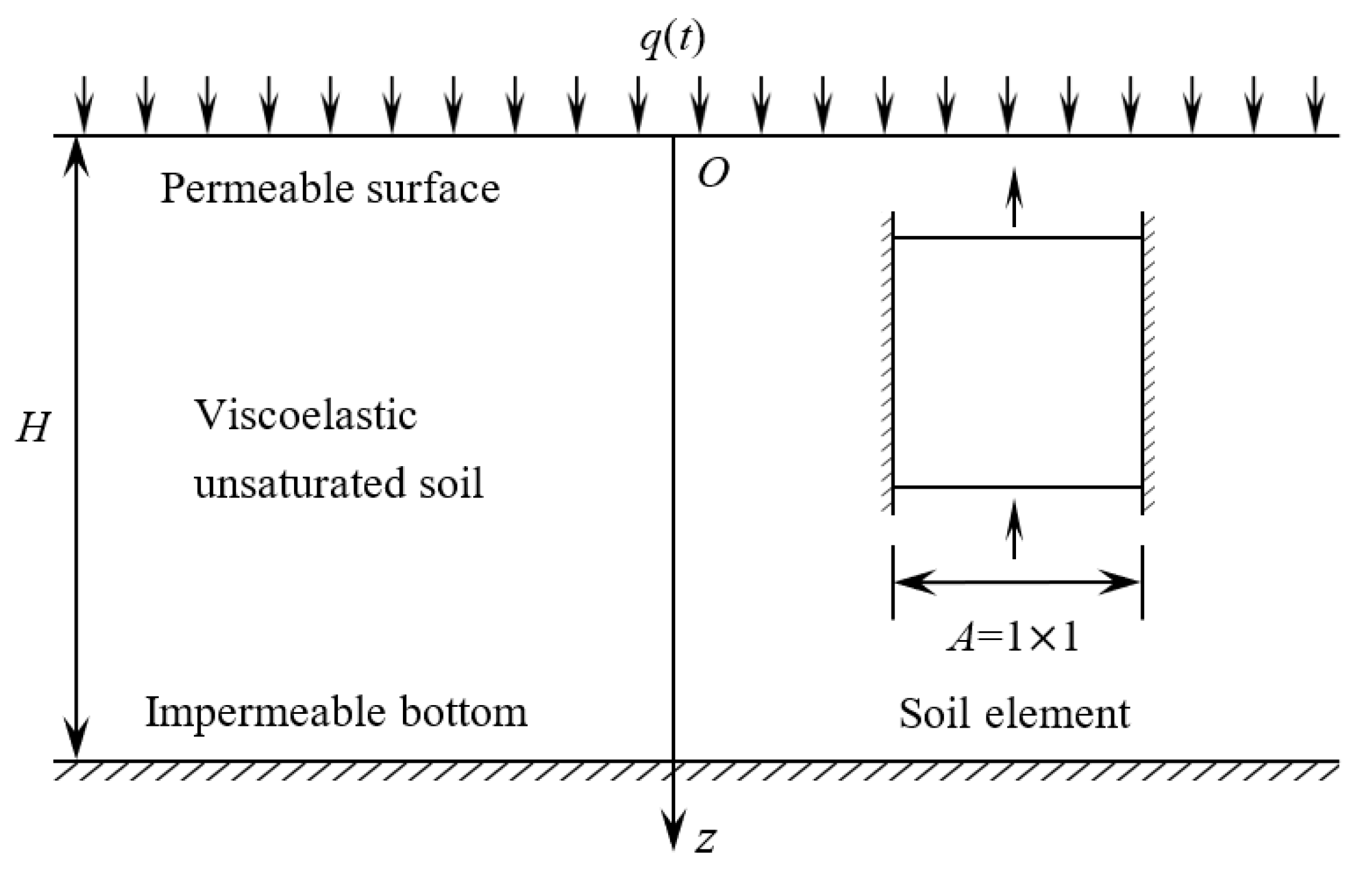

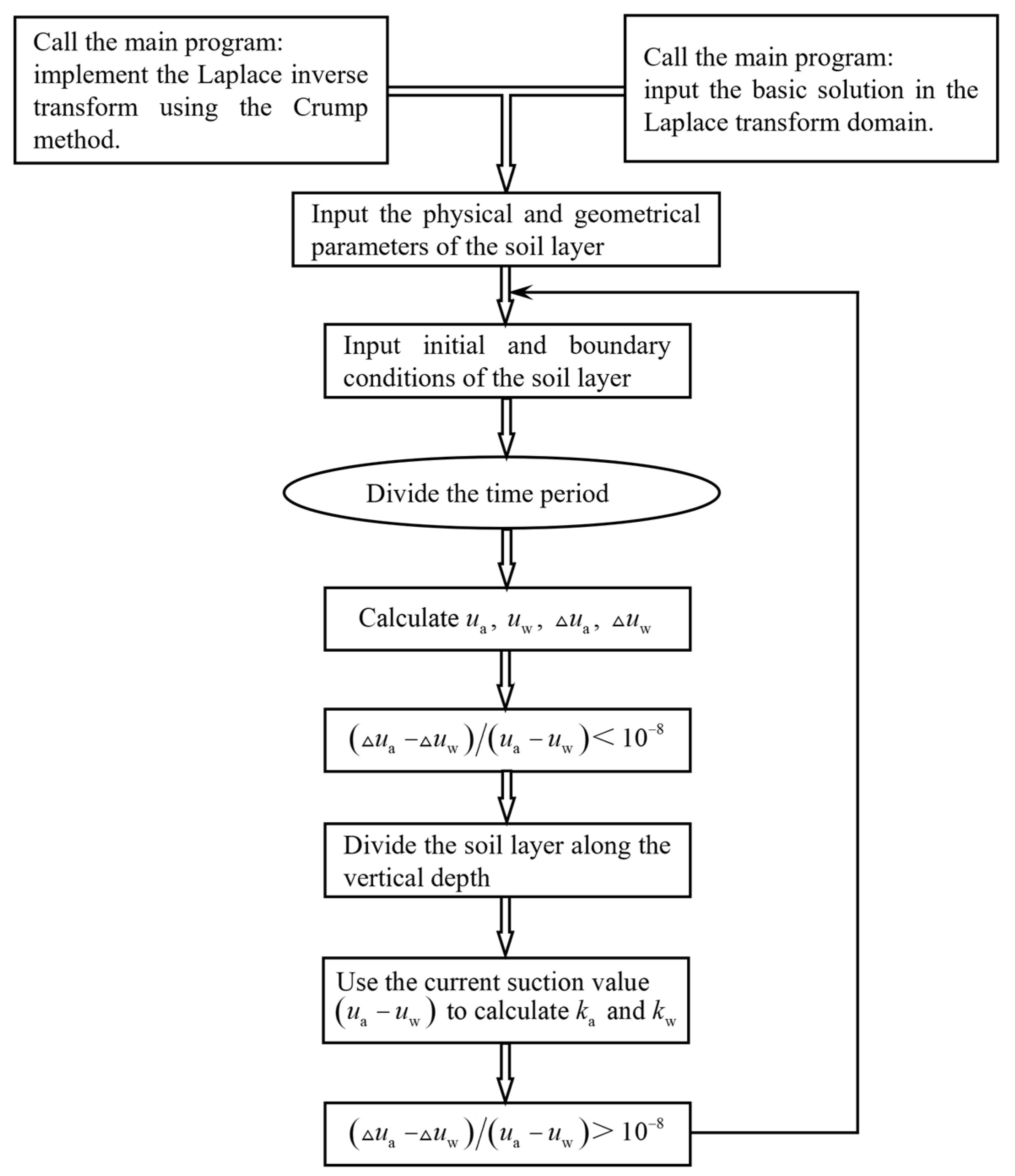

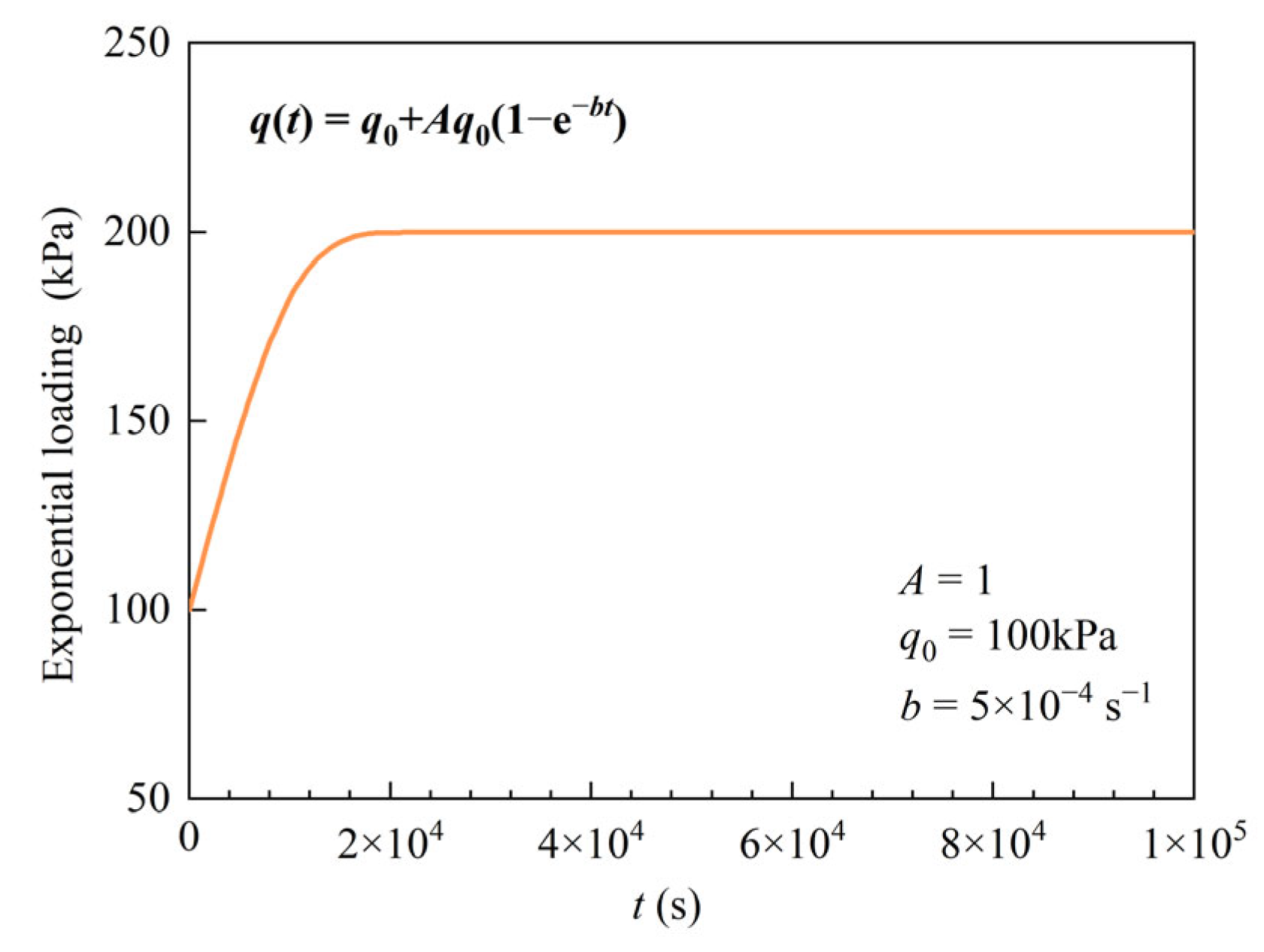
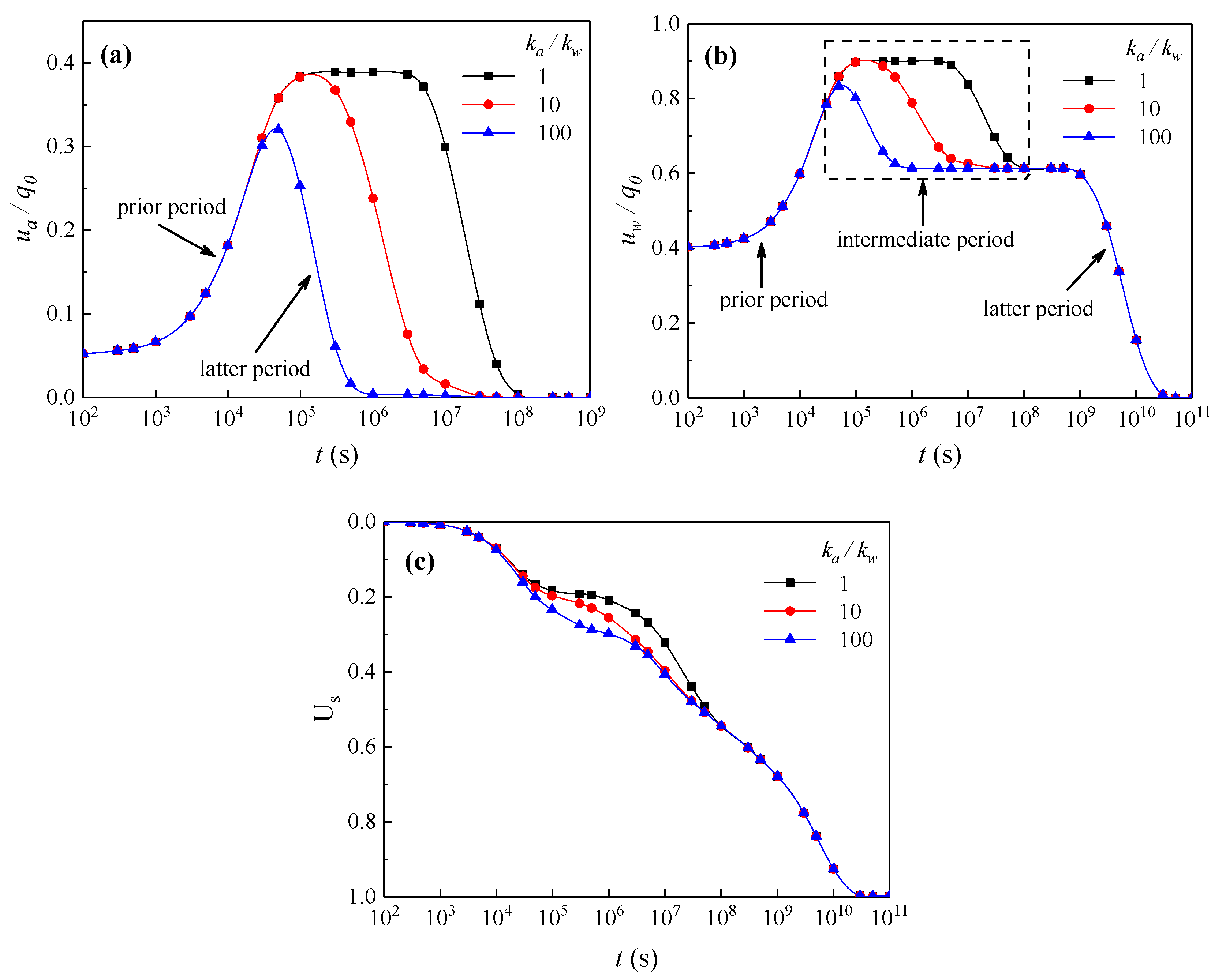
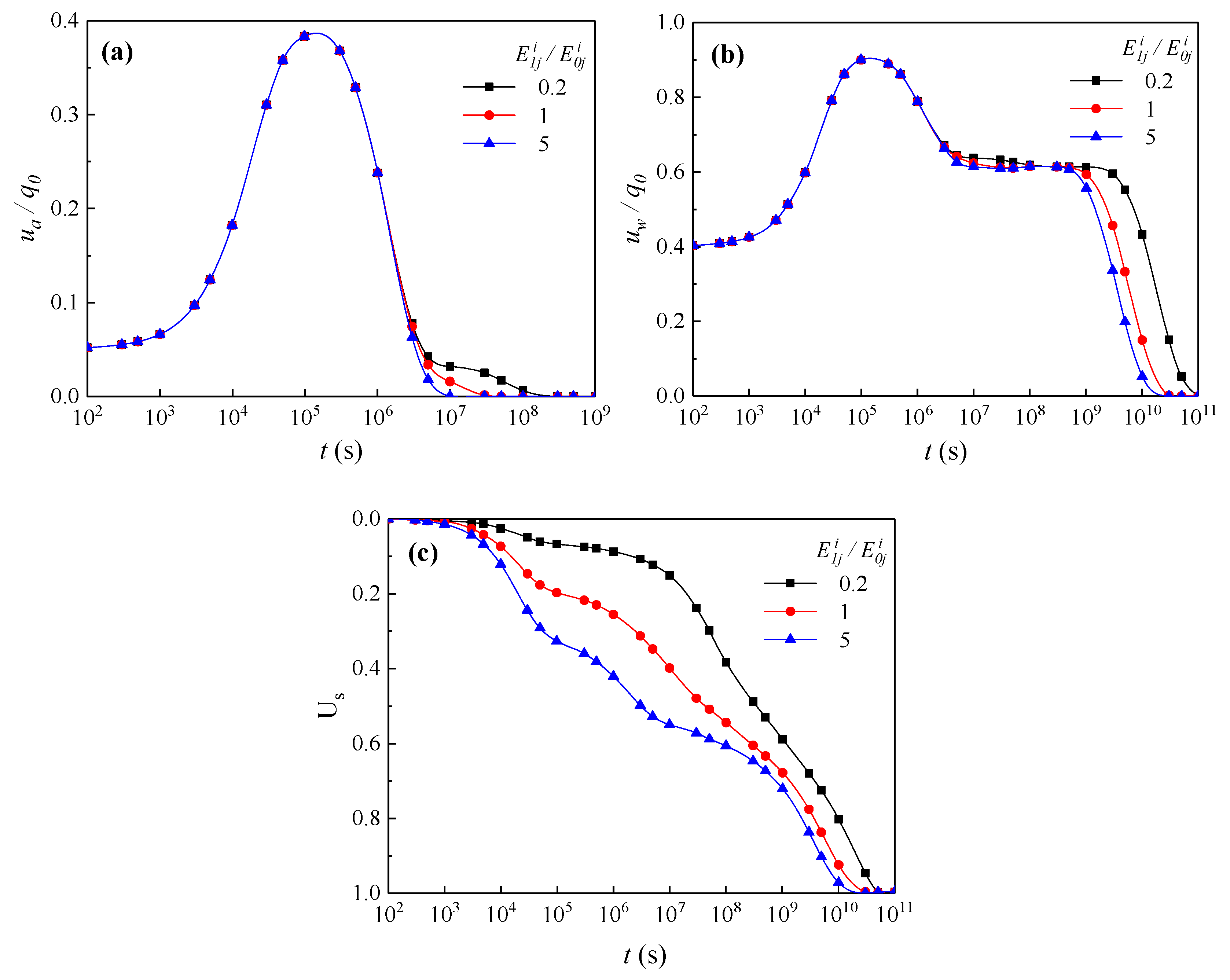
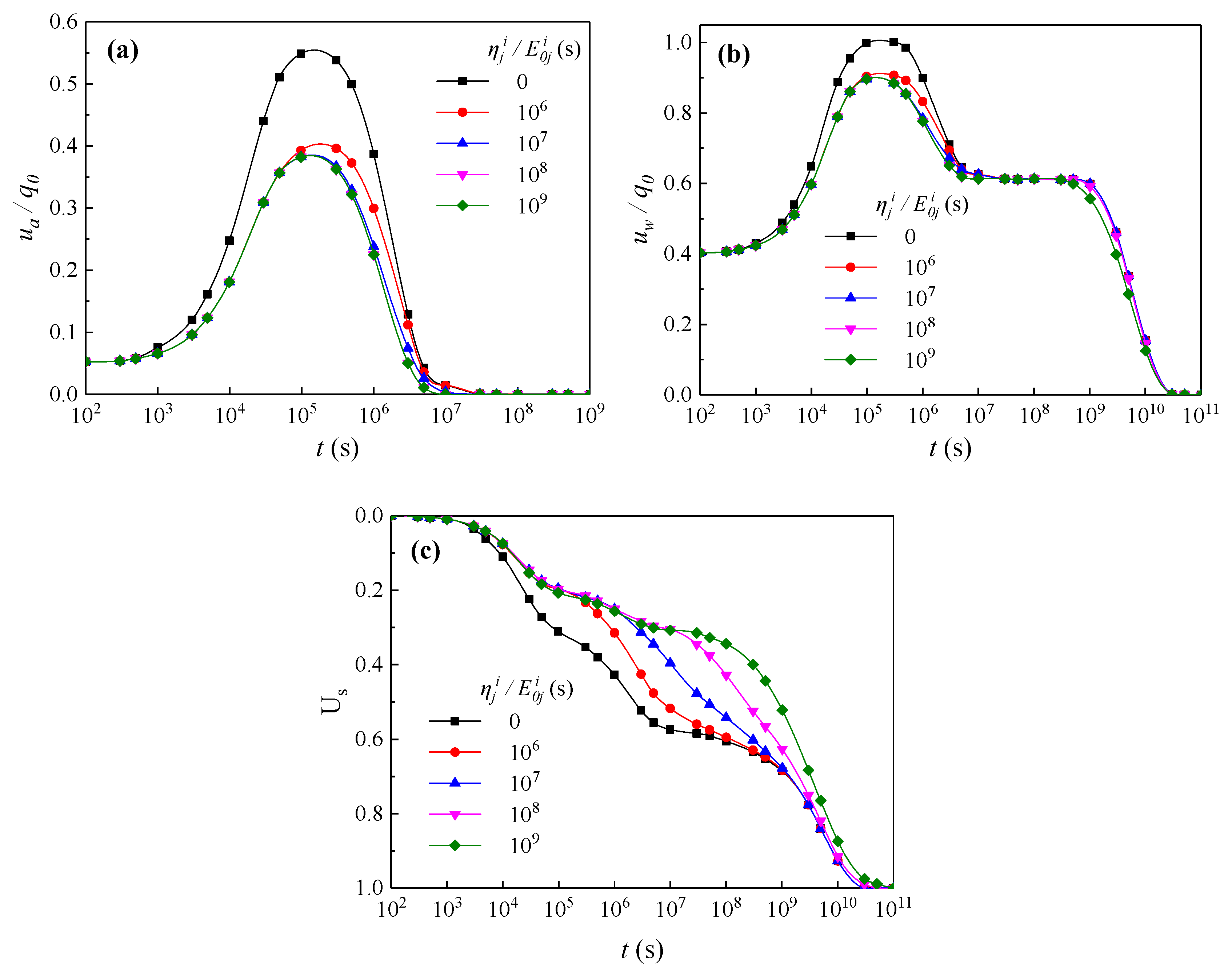
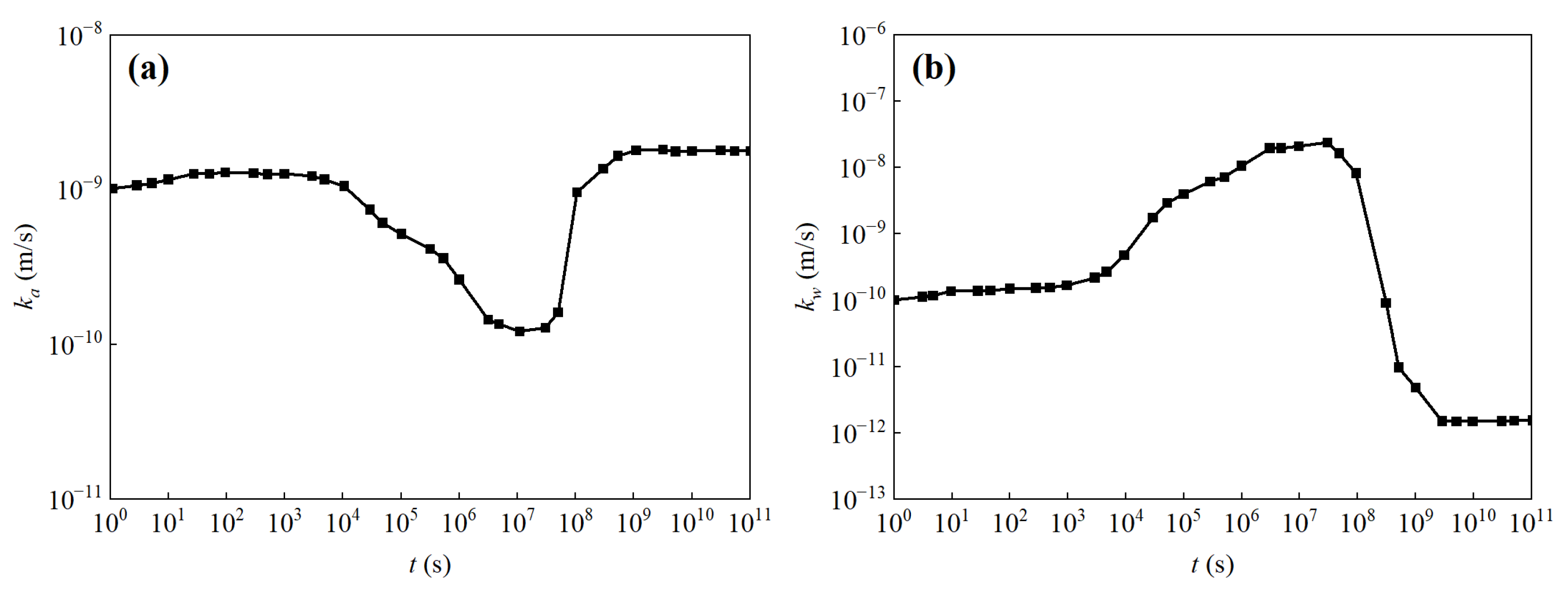
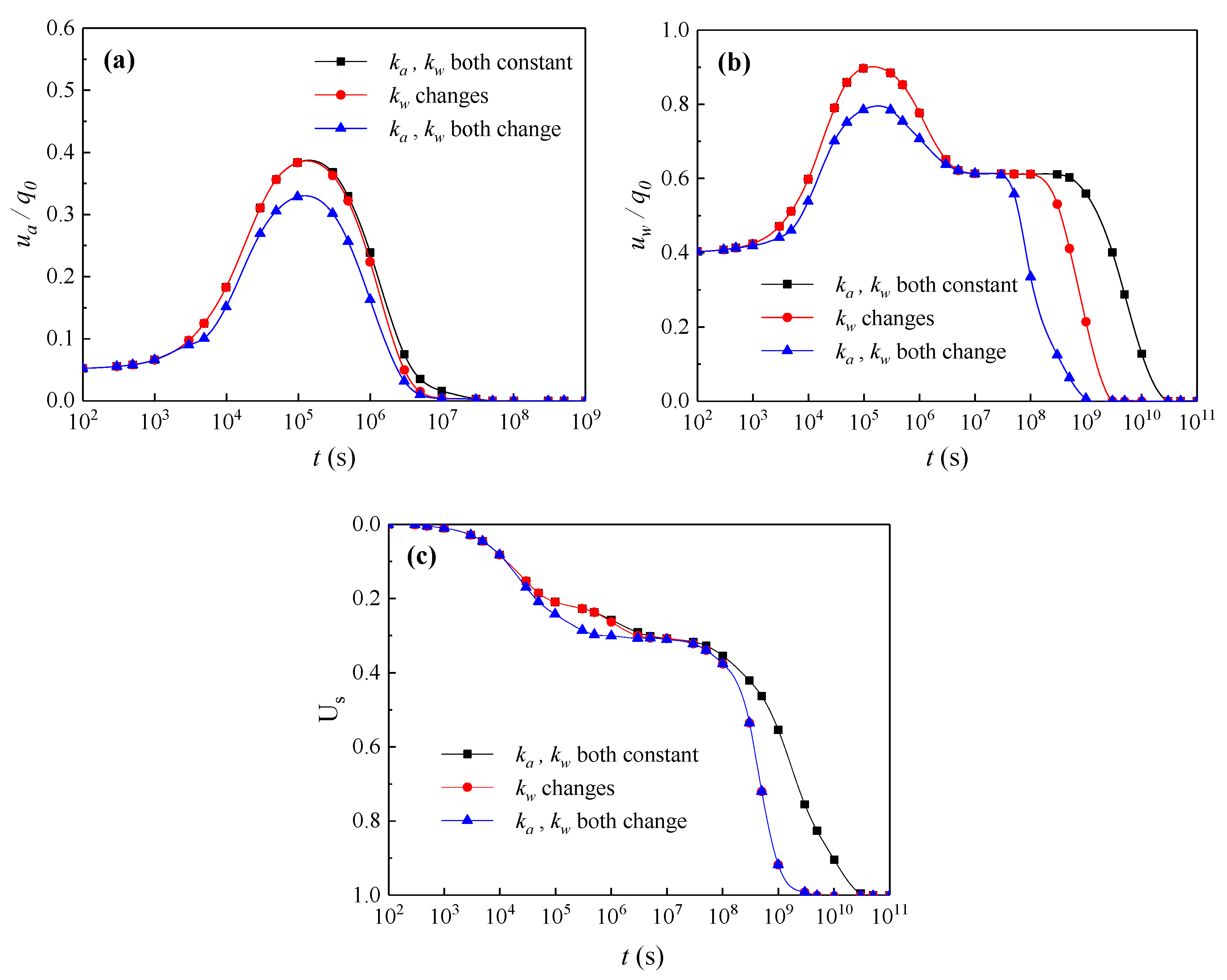
| Parameter | Value | Unit | Parameter | Value | Unit |
|---|---|---|---|---|---|
| 5 × 103 | kPa | 1 × 103 | kPa | ||
| 1.25 × 103 | kPa | 2.5 × 103 | kPa | ||
| 5 × 10 | kPa·s | 1 × 10 | kPa·s | ||
| 1.25 × 10 | kPa·s | 2.5 × 10 | kPa·s |
Disclaimer/Publisher’s Note: The statements, opinions and data contained in all publications are solely those of the individual author(s) and contributor(s) and not of MDPI and/or the editor(s). MDPI and/or the editor(s) disclaim responsibility for any injury to people or property resulting from any ideas, methods, instructions or products referred to in the content. |
© 2025 by the authors. Licensee MDPI, Basel, Switzerland. This article is an open access article distributed under the terms and conditions of the Creative Commons Attribution (CC BY) license (https://creativecommons.org/licenses/by/4.0/).
Share and Cite
Dai, S.; Jiang, L.; Qin, A.; Liao, Y. Semi-Analytical Solutions for One-Dimensional Consolidation of Viscoelastic Unsaturated Soils Considering Variable Permeability Coefficient. Appl. Sci. 2025, 15, 4918. https://doi.org/10.3390/app15094918
Dai S, Jiang L, Qin A, Liao Y. Semi-Analytical Solutions for One-Dimensional Consolidation of Viscoelastic Unsaturated Soils Considering Variable Permeability Coefficient. Applied Sciences. 2025; 15(9):4918. https://doi.org/10.3390/app15094918
Chicago/Turabian StyleDai, Shize, Lianghua Jiang, Aifang Qin, and Yile Liao. 2025. "Semi-Analytical Solutions for One-Dimensional Consolidation of Viscoelastic Unsaturated Soils Considering Variable Permeability Coefficient" Applied Sciences 15, no. 9: 4918. https://doi.org/10.3390/app15094918
APA StyleDai, S., Jiang, L., Qin, A., & Liao, Y. (2025). Semi-Analytical Solutions for One-Dimensional Consolidation of Viscoelastic Unsaturated Soils Considering Variable Permeability Coefficient. Applied Sciences, 15(9), 4918. https://doi.org/10.3390/app15094918






